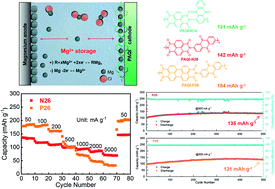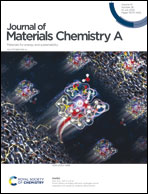Organic-conjugated polyanthraquinonylimide cathodes for rechargeable magnesium batteries†
Abstract
Rechargeable Mg batteries (RMBs) are advantageous for large-scale energy storage because of the abundant reserves of Mg and high safety, but inorganic cathodes suffer from the availability of few species, low capacities, and sluggish Mg2+-diffusion kinetics. Organic materials provide more selections for RMB cathodes with designable structures. However, the open framework of organic RMB cathodes tends to store MgCl+ ions, largely affecting the energy density by making a certain amount of chlorine-containing electrolyte indispensable. Herein, three polyanthraquinonylimides (PAQIs; N14, N26 and P26) were synthesized and investigated as organic RMB cathodes. The large conjugated structure favors high capacities (122 mA h g−1 for N26 and 164 mA h g−1 for P26) and good cycling stabilities (115 mA h g−1 for N26 and 111 mA h g−1 for P26 maintained after 500 cycles), as well as good rate capabilities. More significantly, a comprehensive mechanism study demonstrated that the PAQIs stored Mg2+ rather than MgCl+ through carbonyl enolization, and N26 and P26 delivered high specific power densities of 2780 and 2431 W kg−1, respectively, at 2000 mA g−1. The present study developed high-performance organic PAQI cathodes for RMBs and demonstrated the Mg2+-storage mechanism, and suggests that organic materials based on the enolization chemistry of multi-electron transfer could be potential candidates for high-power RMB cathode materials.



 Please wait while we load your content...
Please wait while we load your content...